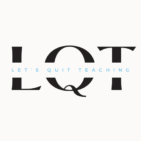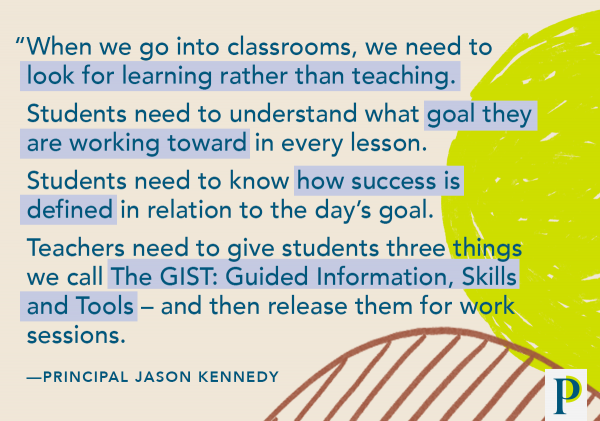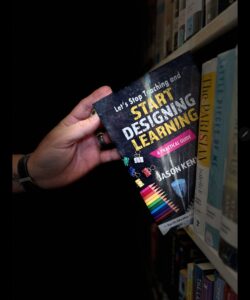Just wanted to share with all of you…
VOICES FROM THE #PRINCIPALPROJECT COMMUNITY
Here’s How I Look for True Learning in the Classroom

by Jason Kennedy | 3.16.22
When I reflect on my first 10 years of teaching, I know it would have been a completely different classroom if I’d known what we know now about student learning.
I came into teaching well versed in my content area, having taken literature classes and secondary English and writing classes, but I didn’t step into the classroom knowing how to make learning happen. I tried doing what I’d seen my own teachers do, and I developed new strategies to engage my students, but my pedagogy wasn’t backed by research.
Over the past several years, educational researchers have uncovered a wealth of knowledge about what learning really means and how to teach for true learning. The research indicates that when teachers invest energy up front in designing lessons according to the Goldilocks principle – not too hard, not too easy, but just right – and provide differentiated tasks and resources for student work sessions, then they can spend less energy on instruction during class and hand the reins over to the students. I often say that we need to “quit teaching and start designing learning,” and this is what I mean by that. By shifting energy to design, teachers can spend class time supporting students in small groups and individually. The engagement will come, because students will be invested in the tasks teachers have designed for them to engage in. Research tells us this.
As a school leader, my work now is trying to communicate what the research says and support teachers in designing for student learning. By investing more front-end energy in lesson design, we ultimately get time back, experience fewer disruptions, generate higher student engagement and drive more equitable outcomes.
Below, I’ll share some of the mindset shifts and indicators of design learning that guide my work as an instructional leader:
When we go into classrooms, we need to look for learning rather than teaching.
There can be a feeling among teachers that they are performing for us when we come in to observe their lessons. We need to set the expectation that teachers have already put a lot of energy into the design of the lesson – and when we see them in the classroom, what we’re really looking for are signs of learning. The Active Learning Framework is shown by research to drive learning, and it can translate into our “look-fors” during observations and coaching sessions.

- Students need to understand what goal they are working toward in every lesson.
The fundamentals of lesson design begin with the question: “What is the goal for today?” Students need to know that goal before they begin learning. If we were going to challenge our students to a foot race, we couldn’t start the race until telling them where the finish line is. So each lesson should begin with pointing back toward the learning target: “Here’s the goal for today’s lesson, and before you leave class today during this lesson, you need to be able to say, “I can identify how figurative language is used by an author in a text.” In the lesson framework I’ve designed with some teachers, class starts by sharing the learning target (or reminding students, if it’s a target that spans multiple sessions), then inviting them with an opening that activates prior knowledge.
- Students need to know how success is defined in relation to the day’s goal.
If a student can say, “I can do _____ well,” they also need to know what it looks like to do that well. What does high-quality, standards-aligned work look like for that day’s outcome? What tasks will allow students to show themselves and their teachers, “Hey, I accomplished this”? Once we identify the task, we can either create or co-create the success criteria for students to use (here’s an example of what criteria might look like). We really can’t give true feedback for a student if we don’t have a shared set of criteria, with examples we can point to.
- Teachers need to give students three things we call The GIST: Guided Information, Skills and Tools – and then release them for work sessions.
Before releasing students to work sessions, teachers give students what I call The GIST: Guided Information, Skills and Tools. What guided information do students need to complete the task today? What guided skills do students need their teacher to model, and what skills will students need to complete the task today? What guided tools do I need to walk you through – such as anchor charts or flowcharts or other processes?
When students have that goal and that success criteria, the teacher can release them to work time, and grab a group of five students who might need extra support. Meanwhile, the other students are working through the tools or following a pathway toward acceleration.
In this model, about 25% of instructional time is spent with teacher-directed instruction to provide the GIST, and the rest of class is student work time, as they progress toward high-quality tasks that move them toward the learning target. This approach gives learning back to whom it belongs, which is the students.
Here’s an example of an active learning lesson plan template that I’ve used with my team.
There are a few cultural shifts that support success with the design learning framework:
We need to shift from rewarding “good students” to developing “good learners.”
Our students have grown up inheriting old ideas about how a “good student” behaves. “Good students” are quiet, they raise their hands, they wait to speak until they’re called on. But all those behaviors are compliance-driven. They don’t tell us anything about whether a student is learning.
We need to instead communicate to our students and teachers what it looks like to be a “good learner.” When they look around our classrooms and ask themselves, “OK, what is my place in all this as a learner? What do good learners do?,” we want to make sure they find space for their full selves. Because “good learners” talk, good learners are active, good learners ask questions. Good learners make mistakes, good learners know how to pull themselves out of a pit when they’re stuck in their learning. This shift will energize our classrooms and invite all of our students into the process of learning every day.
We need to create a culture that celebrates mistakes.
As leaders, we set the culture in our buildings. We need to tell students from the first day they enter our school, “Hey, we love mistakes because mistakes show that we got a chance to learn something new.” And we need to encourage our teachers to communicate the same message. Fear of mistakes is a motivation killer. We have to be speaking the same language schoolwide about mistakes as a part of the learning process and just a window of opportunity. We want to hear our students start saying to each other, “Hey, mistakes are OK. Hey, you made a mistake. Hey, that’s great. We’re about to learn something together.”
We need to meet our teachers where they are and move one step at a time.
Everyone in a school community has an internal compass, and it should point toward learning every day. If this type of lesson design is new to a school community, the process of transition needs to happen step by step. For example, I’m at a new school this year, and the one step we implemented at the start of this year was making sure we have student-friendly learning targets posted and refer to them throughout each lesson. Next, we’re moving toward developing the success criteria for the tasks that we’re asking students to complete.
Making this shift takes teacher buy-in, and buy-in comes from seeing results. In other words, success is the motivator, and the more success we have, the more we want. So once teachers get a little bit of a taste of the power of this approach, and students get a little taste of their learning success, they want more. They will go further.
Recommended Reading:
| I strive to read widely to keep up on the latest research on student learning. I’m a big fan of Peter Dewitt and John Hattie’s work on teaching and learning, as well as material published by Corwin. If I had any reading recommendation to a teacher or leader interested in what design learning looks like in the classroom, it would be Chapter Three of Suzy Pepper Rollins’ Teaching in the Fast Lane. With these resources and others, it’s all about learning what the research says and then considering what you can take to your own particular school community. |
About the Author

Jason Kennedy
Jason Kennedy is an assistant principal in Georgia. You can follow him on Twitter at @letquitteachin.All posts by Jason Kennedy« Back to Blog Page


